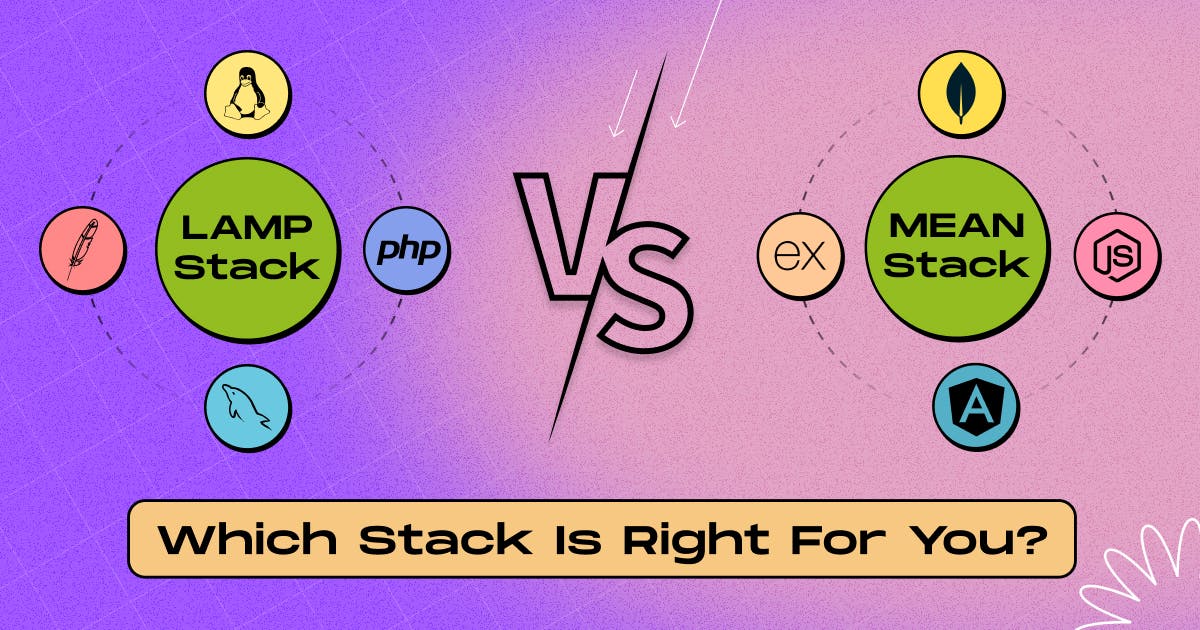October 10, 2023
LAMP vs. MEAN: Which Stack Is Right For You?

Nusrat Sarmin

Many web development stacks have evolved over the years. Two of the most popular stack choices are the LAMP Stack and the MEAN Stack. Both of these stacks offer their own unique advantages when it comes to building a website or web application.
Here's an in-depth comparison of the two stacks LAMP vs. MEAN. Let's explore so that you can make the perfect choice for your next thriving project.
What Is a LAMP Stack?
Michael Kunze introduced the term LAMP stack in 1998. LAMP stands for Linux, Apache, MySQL, and PHP. Each component plays a crucial role in the stack. It is open source and one of the most reliable tech stacks in the modern web development realm. It provides a powerful and flexible platform for creating dynamic websites and applications. LAMP is designed to create applications without needing external software or data.

Let's break down the components of LAMP Stack:
👉 Linux: This operating system provides a stable and secure environment for hosting web applications.
👉 Apache: A widely-used web server that can handle a variety of configurations and is known for its reliability.
👉 MySQL: A relational database management system (RDBMS) that is powerful and widely used for structured data storage.
👉 PHP: A server-side scripting language known for its simplicity and popularity in web development.
Pros & Cons of LAMP Stack
Pros of the LAMP Stack:
✔️ Open-source and Free: LAMP is all open-source and non-proprietary. You can avoid vendor lock-in and use the software stack without paying a license fee.
✔️ Flexible: The components of the LAMP stack are highly flexible. You can choose the best components for your projects or business needs.
✔️ Scalability: The components of the LAMP stack are highly scalable, allowing users to easily expand their applications as their needs grow.
✔️ Support for Multiple Programming Languages and Databases: The LAMP Stack supports several web programming languages and databases. Give developers flexibility in choosing a programming language and database that suit their project.
✔️ Large Community Support and Resources: LAMP has been in use for a long time, and there is a wealth of resources and community support available.
✔️ Easy to Learn: PHP and MySQL are easy to learn and widely adopted.
Cons Of LAMP Stack
❌ Not suitable for Real-time applications: PHP may not be the best choice for highly complex or real-time applications.
❌ Server-Side JavaScript: While PHP is used for server-side programming, JavaScript frameworks are needed for client-side programming. Additionally, it has limited support for modern server-side JavaScript frameworks.
❌ Complexity: Managing multiple components and their dependencies and ensuring they work together smoothly can be challenging.
❌ Limited To Linux OS: It does not support operating systems other than Linux.
❌ Security Risk: LAMP stack security is a major concern. Regular updates and security patches are necessary to ensure protection against vulnerabilities.
❌ Resource-intensive: Apache is a resource-heavy web server. This may become a bottleneck for high-traffic websites.
What Is The MEAN Stack?
In 2013, Valeri Karpov coined the term MEAN however it was first created by Austin Anderson. MEAN refers to MongoDB, Express.js, Angular, and Node.js. It's a full-stack JavaScript stack, offering a unified development experience for both the front-end and back-end.

Let's break down the components of MEAN Stack:
👉 MongoDB: A NoSQL database that stores data in a JSON-like format, making it flexible and scalable.
👉 Express.js: A minimal and flexible Node.js web application framework that simplifies building robust APIs.
👉 Angular: A front-end JavaScript framework for building dynamic and interactive web applications.
👉 Node.js: A runtime environment for executing JavaScript code on the server-side.
Pros of MEAN Stack
✔️ Open-Source: All the components of the MEAN stack are open-source. Developers can use and modify for free. This makes it an ideal platform to create custom applications without spending money on proprietary software.
✔️ Full-stack JavaScript: MEAN uses JavaScript for both the front-end and back-end. It reduces language switching for developers. Hence, they can effectively manage the database, front-end, and back-end simultaneously with minimal complexity.
✔️ Scalability: MongoDB's NoSQL nature makes it easier to scale horizontally.
✔️ Real-time Applications: Node.js is known for its event-driven, non-blocking I/O model. It is well-suited for building real-time applications, such as chat applications or streaming services.
✔️ Performance: The MEAN stack is designed to be more efficient than a LAMP stack, resulting in faster response times and improved performance.
✔️ Flexibility: MongoDB's schema-less design is flexible and adaptable to changing business needs, making it valuable in dynamic development environments.
✔️ Rapid Development: The MEAN stack uses ready-made tools and libraries, along with the simplicity of JavaScript making development faster.
✔️ Active Community: A large and active community of developers meaning you will get plenty of support and resources.
Cons of MEAN Stack
❌ Learning Curve: If your team is not already familiar with JavaScript, there might be a learning curve to consider.
❌ Rapid Changes: JavaScript frameworks like Angular undergo frequent updates. Staying up-to-date with these changes can be challenging.
❌ Database Limitations: MongoDB's document-oriented nature may not be the best fit for applications with complex, highly relational data structures. In such cases, a relational database might be more appropriate.
❌ Not suitable for all Use cases: MEAN is versatile, but may not be best for all applications. Content-heavy websites or projects relying heavily on relational databases may find LAMP more suitable.
What Are the Key Differences Between the LAMP Stack and MEAN Stack?
Here's a side-by-side comparison of LAMP vs. MEAN to help you understand their key differences and similarities:
| Aspect | LAMP Stack | MEAN Stack |
|---|---|---|
| Components | Linux OS, Apache, MySQL, PHP. | MongoDB, Express.js, Angular, and Node.js |
| Programming Language | PHP for server-side scripting. | Javascript for both front-end and back-end development. |
| Database | MySQL, a relational database. | MongoDB, a NoSQL database. |
| Web Server | Apache, a well-established web server. | Express.js, a minimalist web application framework for Node.js |
| Front-End Framework | Typically uses JavaScript and HTML/CSS for front-end development. | Angular, a comprehensive front-end framework for building dynamic web applications. |
| Back-End Language | PHP for server-side logic. | Node.js for server-side logic. |
| Real-Time Capabilities | Limited real-time capabilities with additional technologies. | Strong real-time capabilities, thanks to Node.js |
| Scalability | Scalable, but may require additional configuration. | MongoDB's NoSQL nature allows for scalability with ease. |
| Learning Curve | Fairly easy to learn. | Can have a steeper learning curve, especially for beginners. |
| Flexibility | Less flexible than its competitor for unstructured or semi-structured data. | Flexible because of its modular nature. |
| Community and Resources | Well-established and vast community with extensive resources. | Active community with a growing set of resources. |
| Use Case | Well-suited for content-heavy websites, e-commerce web applications, and traditional web applications. | Suitable for a wide range of applications, especially for real-time, video-streaming web applications. |
| Maturity | Established and mature technologies. | Some MEAN stack components evolve more frequently. |
| Complexity | Generally simpler to set up and manage. | Can be more complex, especially for developers new to JavaScript. |
| Development Speed | Dependency on multiple languages makes development slower. | Faster development is thanks to its use of a single language (JavaScript). |
LAMP vs. MEAN: Which One Is the Right Stack for Your Web Development Project?
When deciding between LAMP and MEAN, consider the following factors:
👉 Consider Your Project Requirements: Assess your project's specific needs. LAMP excels at content-heavy sites and projects with structured data needs. while MEAN shines in real-time applications and dynamic and interactive web apps.
👉 Developer Expertise: Your team's skills and familiarity play a role. If they're JavaScript-savvy, MEAN might be a natural choice. If they are proficient in PHP and MySQL, LAMP will be more comfortable.
👉 Sacalabilty: If scalability is your top priority, especially for rapidly evolving data MEAN's NoSQL database and Node.js can be advantageous.
👉 Flexibility: LAMP works well for Structured data, but requires additional steps for handling unstructured or semi-structured data. MEAN is highly flexible and adaptive to changing data structures. It's well-suited for applications with evolving data needs. Thanks to MongoDB's NoSQL design.
👉 Development Speed: MEAN may offer faster development, using a single language (JavaScript) across the stack accelerate the development process.

MERN Stack vs JAMStack: Which Is Right for You?
Recap
In the LAMP vs. MEAN battle, there's no one-size-fits-all answer. Both stacks have their strengths and weaknesses, and the choice should align with your project's specific needs.
LAMP is commonly used for traditional web applications and content-heavy sites. It is often an excellent choice for small to medium-sized projects where the complexity and scalability requirements are relatively low.
While MEAN offers advantages in terms of real-time capabilities, scalability, and the use of a unified programming language (JavaScript) throughout the stack. This is particularly valuable for dynamic and interactive user interfaces where user interactions or real-time data updates are crucial.
Regardless of which stack you choose, it is important to stay updated with the latest trends and best practices in order to achieve a successful project. Because technology is constantly evolving and changing the web development landscape.
Are you on a journey to create a fantastic web application but feeling a bit lost in the wilderness of technology stacks? Don't worry; you're not alone! StaticMania is ready to help you deliberately. Let's discuss to find the right path for your web development adventure.

